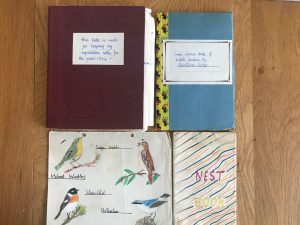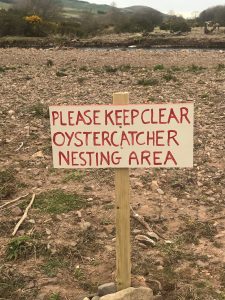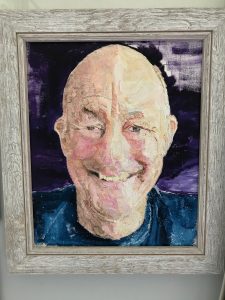BIRDWATCHING DAYS
The pall of a global pandemic hangs over us. Should humankind emerge from it the message is clear; things must change. Some might say that we shouldn’t have needed such a traumatic wake up call but it is imperative that a new global connectiveness must now come into being, one which values all peoples and our common planetary home. Let us hope that as Ben Okri says that when we come out the other side “other voices will be heard…ones that speak for nature, for the poor, for justice.” (1) Such is the magnitude of the moment. All we can do in the present is get by the best we can.
For me it has meant gardening and a look back over a lifetime of nature diaries. Rummaging through my earliest archives, I have been struck by one over riding fact: my childhood and early teenage years were spent roaming around Combe and its Evenlode valley, Knott Oaks wood and the nearby Blenheim park. Precise dating tells me that a week hardly went by without me being out and about: a golden age of freedom with each adventure diligently recorded in ‘Expedition Notes’, ‘Nature Reports’ or ‘Birds Nests’. What follows are extracts from those copious early records.
THE EARLY YEARS
1960 Aged ten. “Our school outing to London. We left Combe at 8.05 am. We went to Oxford on the diesel to London. We went on the Underground and went to Kensington gardens for lunch. I sat near the round pond. On the pond there some ducks like Mallard and Tufted ducks. On land were the usual pigeons, and sparrows looking for titbits. The Mallards had some fluffy chicks.”
1960. Birds Nests by Christopher Archer. During that spring sixty nests were discovered including blackbirds, wrens, moorhens, whitethroat, great crested grebe. Here is a specific, typical full record.
Blackbird’s nest at bottom of hill by holly bush.
March 15th 3 eggs
March 25th 4 eggs
March 26th 1 babe hatched out.
April 2nd. All babes hatched out.
1960 August 23rd. “This evening Roger ( a friend two years older), at about 8 pm, went down the pond which is at the bottom of the Firs. On the pond were two moorhens nests and further on we found four baby ones. We had a close look at one. It was a pretty little thing about the size of a baby chicken and mostly black, a bit of red on its beak.”
1961. January 14th. Our neighbour and avid birdwatcher, Mr C Emden sought to encourage my interest. He had enjoyed reading my diary and followed it up with a gift, a pair of opera glasses, a sort of mini binocular. This is how I recorded its first outing.
“Today while trying out my new binoculars down Gritney hillI I saw four pheasants, four blue tits,a wren and hedge sparrow. One of these blue tits was right at the top of a tree but I could see it easily doing its acrobats with my binoculars”.
1962. April 10th. The Evenlode river was flanked by marshy water meadows, a bird nirvana, hence I was often there. On this particular day aged twelve, “ I slowly edged my way further down the hedge to see if I could get a better view of the birds. This was quite successful because I saw four snipe. Suddenly five redshank flew up making a terrific noise.”
On hearing of my experience Mr Emden wrote me an encouraging note with a tip on something else to look out for “ the redshank is one of the most attractive of waders. They seem to like standing on the fence posts”.
Teenage years arrived yet there was no let up on being out and about which lead to some memorable bird spotting moments.
1964. April 6th. “Crossbills spotted in Knott Oaks wood”.
April 13th. “Being the last day of the holidays, I thought that it would be a good time for a birdwatching trip to Blenheim park.” At the Cascades Great Crested Grebes were observed performing their courtship ritual that is the weed dance, facing each other and shaking their heads. There are other parts of the dance but that is as far as the pair progressed”. No weed in sight then!
July 20th. Cuckoo fledgling found in hedge sparrows nest near Upper Westfield farm.
1965. April 13th. First ever sighting of a redstart. “ I was not sure what species of bird it was at first.”
Teenage years were by now offering new horizons and the formative birdwatching years were coming to an end. It prompted this plaintive note. “Due to O levels I have not been able to build up a very good picture of the breeding habits of birds in my area”.
Still, notwithstanding this turning point, on one day in those summer holidays beside the river “I stood on the bank looking into the water when I heard a peculiar whistle. I looked up and saw a kingfisher fly onto a branch about five yards in front of me. The bird’s plumage was magnificent. As it sat on the branch the birds neck seemed to rotate as it peered into the water. Then without any warning it dived into the water, emerged and flew downstream, all in the space of three seconds. When the bird entered the water hardly any splash was formed. As it emerged, I could see no trace of any catch, although the fish might have been very small”.
With summer nearly over, one excursion remained. The prolific life of aquariums and a zinc bath terrarium needed returning to their natural habitat and so …
July 28th. “Today I took four more frogs to Colliers pond. This brings the total to seventy nine.”
A good way to end those formative years.The times though were changing in other ways and not for the better there on my home patch. The valley was under attack from drainage and the claiming of the water meadows and marsh areas for agricultural planting.This heralded the end of the snipe and redshank on the marsh just as I was leaving home.
MIDDLE YEARS.
With new horizons opening up on all fronts birdwatching became an infrequent pastime. Still foundations had been well and truly cemented and set. Dad had given me a pair of Zeus 10×50 binoculars as wages for our holiday labouring while Mum took my reference books to the highest level with a complete set of Witherby, the acme of bird books.
It was a decade though until this kit was fully operationalised; a decade which saw urban living give way to a welcome return to rural life. Location? The Fenlands of East Anglia. A birdwatching mecca which inspired a return to journal writing.
Late December 1980. “Where the Nene runs into the Wash”
“It was a cold morning, bright and windy. The river bank was sodden and shallow pools of water stood reflecting the bright sunlight. Looking upstream the Nene arrowed straight to a point in the mist. Downstream the mud above the waterline shone and out towards sea the flats were dotted white with birds.”
A welcome and familiar sound from the past was heard followed by a major surprise “redshank trill turned my head and there a few feet above the crest of the embankment two large birds of prey glided effortlessly…….on outstretched upturned and deeply fringed wings……no mistake. With the sun on the pure grey wings, the male hen harrier looked resplendent. the rump bar was pure white against the tawny brown of the reed bed.”
March 3rd 1982. This day saw me looking back over four years of unique birdwatching in this unique habitat; a retrospective prompted by our imminent move north to Scotland.
“The Ouse Washes at Manea was an important place for me. Resplendent wildfowl, my first pintail, the whistle of the wigeon, the bewwick swans, short eared owls and a major first sighting. One afternoon I was casually scanning the marsh from one of the hides……when to my left the wildfowl suddenly burst into flight and scattered. A large bird of prey, dark brown with a pale yellow-white forehead drifted into view. My first marsh harrier. It was joined by a companion, a bird with a more streaked back, but still very dark, the male I think. For the next twenty minutes they drifted back and forth over the washes sometimes only a few feet above the vegetation and often dropping down into it. My lasting image will be one of the birds riding against the wind, six feet above the ground, motionless, with Ely cathedral silhouetted directly behind.
LATER YEARS
Town Yetholm, there in the Bowmont valley, with a nearby pond, loch and beyond the Cheviot hills and Northumberland coast has been the birdwatching haunts for the past thirty eight years. A few of many special moments during some of that time are reproduced below.
1983. March 12th. This was a time when my recording efforts extended to the weather. “A calm day(Max 11 degrees C Min 5 degrees C) hazy sunshine until noon. Spring is in the air. Joe and Sam came home very excited at having found their first frogspawn by the river. We made a second aquarium for it.”
April 17th. “A magnificent day at Bamburgh. ( Max 14 Min 2) Bright sunshine, fluffy clouds, our first swallows and terns. Eider floating leisurely before the rocks and fulmar flying low over the waves. Primrose and coltsfoot in the dunes.”
1985. July 1st. “(Max 26 Min 12) Warm, sunny, fluffy clouds. The finest day of the year: a great day for Beth to be born. I watched two rabbits scampering in the field and a moorhen down by Melton Mains ( the drainage ditch ) as I got dressed before setting off for the hospital.”
Driving back ( obviously relieved and elated I felt the need to record the day in my time honoured way “the view towards the hills and home was magnificent . The evening sunshine made the garden and porch indoor garden magical with the primula the deepest of pinks, the lupins, irises and sweet williams a patchwork of whites, yellows, reds and pinks. The first snapdragons are coming out along with the blue irises in the border. Tadpoles in the pond have rear legs and goldfish chase each other round and round perhaps with a view to mating. (as for bird life?) well apparently on our allotment “the chicks are thriving and the cockerel is resplendent in his green and black plumage. All is well.”
1989. October 28th. “An afternoon break in the weather saw the valley bathed in warm autumnal sunshine with all the seasonal colours ( yes you guessed it !) resplendent. Beth and I and Rory(our dog) walked amongst it crossing the river , ‘journeying’ (Beth’s word) along the path at the foot of Chestnut wood and clambering down the steep bank towards Green bridge. She was in a climbing frame of mind for beneath the beeches she scrambled amongst the roots, ‘the giant traps’, helping Dad along the way. Slugs were tucked into the crevices on one of them much to her delight and so one of them spent the next ten minutes crawling up her arm while being thoroughly investigated. It’s front antennae must have been retracted fifty times as she gently enjoyed the creature. Redwings and field fares worked their way up the haugh. Flies basked in the warmth on the sunny side of tree trunks. It was one of those pure days at the turning point of the year.
1990. September 13th. A moment in time. “Beth and I started the day by putting the hens back in their run. We forgot to shut them up last night. Then it was off to school with popcorn in her bag and Rory on the lead. After our customary chat to the cats on the way, I left her at the corner of the builder’s yard. “You go on Dad; big girls go in on their own”. So I did. Back in the haugh I noticed how the mist had bejewelled every cobweb with droplets. Me and Rory walked on to the pond. If there was ever was a morning on which the universe was created then it must have been like this. Warm, perfect clear light, ripples twinkling, cobwebs be decking the gorse as far as the eye could see. Red Admirals were on the wing and coal tits busied themselves in Corner copse. We sat at the far end of the pond. The water was still and green,reflecting the greenness of the trees around, green that is except for the thousands of white feathers which floated on the surface courtesy of the swans, their cygnets and all the other ducks. Swallows were very active, flying back and forth dipping into the water, gathering in the alders out in the middle, then wheeling and whistling their way into flight. Herons stood lazily in the sun, one on the old swans nest, the other in the alder.I could see its eye blink and the blue sheen of its legs caught in the light.Then it was up and away when a swan took off from left to right, pure white set against the liquid green. A few seconds later three large cygnets paddled the length of the pond to join the parent at the other end. A robin sang in the branches above me, perhaps the most poignant of September sounds. We walked home.”
LAST WORD
From 1960 to 1990, many halcyon days were spent immersed in the world of birds and more. Those moments were picked out, preserved, for reasons barely known. Fast forward to now and the reason looks a little clearer. In contrast to today they evoke a paradise, reminding us of what we are fast losing. Indeed many contemporary observers go much further and openly talk of an approaching mass extinction. Is the current pandemic an harbinger of that fate or a global call to act collectively to prevent it? “Optimists believe there is hope that we might begin to see the world differently.”(2)
Small steps in accordance with that spirit are available to us all. Long ago I was powerless to prevent the demise of a water meadow and it’s bird life. Up here at the foot of the Cheviots it is oystercatchers not redshank who are in peril, their nesting sites beside upland rivers are prone to disruption by walkers and dogs. Hence my home made signs below.
It is not too late to act.
References
Okri. Ben. Guardian 27/3/20
Baker. P. C. Guardian 31/3/20



